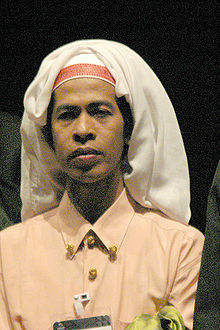| Part of a series on |
| Transgender topics |
|---|
|
|

The Bugis people are the most numerous of the three major ethnic groups of South Sulawesi, Indonesia,[1][2] with about 3 million people. Most Bugis are Muslim, but many pre-Islamic rites continue to be honoured in their culture, including the view that gender exists on a spectrum.[3] Most Bugis converted from Animism to Islam in the early 17th century;[4] small numbers of Bugis have converted to Christianity, but the influence of Islam is still very prominent in their society.[5]
In contrast to the gender binary, Bugis society recognizes five genders: makkunrai, oroané, bissu, calabai, and calalai.[6] The concept of five genders has been a key part of their culture for at least six centuries, according to anthropologist Sharyn Graham Davies, citing similar traditions in Thailand, Malaysia, India and Bangladesh.[7]
Oroané are loosely comparable to cisgender men, makkunrai to cisgender women, calalai to transgender men, and calabai to transgender women,[6] while bissu are loosely comparable to androgynous or intersex people and are revered shamans or community priests.[7] The classification of the calabai, calalai, and bissu as third genders is disputed. These roles can also be seen as fundamental occupational and spiritual callings, which are not as directly involved in designations such as male and female.[8][9]
In daily social life, the bissu, the calabai, and the calalai may enter the dwelling places and the villages of both men and women.[5]
- ^ Peletz, Michael G. (2009). Gender Pluralism: Southeast Asia Since Early Modern Times. Routledge. ISBN 978-0-415-93161-8. OCLC 351812201.
- ^ Pelras, Christian (1996). "The Bugis (abstract)". Journal of Southeast Asian Studies. 30 (2). Oxford: Blackwell: xiii, 386.
- ^ Davies, Sharyn Graham (17 June 2016). "What we can learn from an Indonesian ethnicity that recognizes five genders". The Conversation. Retrieved 27 February 2019.
- ^ Pelras, Christian (1997). The Bugis. John Wiley & Sons. p. 4. ISBN 978-0-631-17231-4.
- ^ a b June, Karlana (23 February 2015). "The Bugis Five Genders and Belief in a Harmonious World". Prezi. Retrieved 27 February 2019.
- ^ a b Graham Davies, Sharyn (2006). Challenging Gender Norms: Five Genders Among Bugis in Indonesia. Case Studies in Cultural Anthropology. Thomson Wadsworth. p. xi. ISBN 978-0-495-09280-3. OCLC 476076313.
- ^ a b Ibrahim, Farid M (27 February 2019). "Homophobia and rising Islamic intolerance push Indonesia's intersex bissu priests to the brink". Australian Broadcasting Corporation News. Archived from the original on 27 February 2019. Retrieved 27 February 2019.
- ^ Boellstorff, Tom (2005). The Gay Archipelago: Sexuality and Nation in Indonesia. Princeton University Press. pp. 38–40.
- ^ Idrus, Nurul Ilmi (2016). Gender Relations in an Indonesian Society. Brill. pp. 32–35.
© MMXXIII Rich X Search. We shall prevail. All rights reserved. Rich X Search
